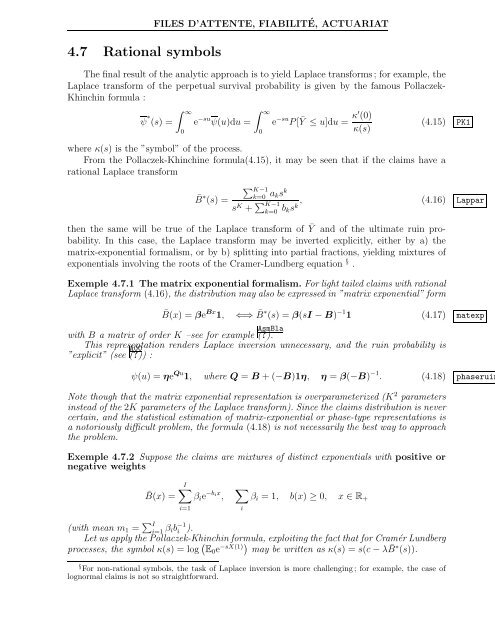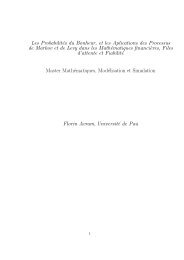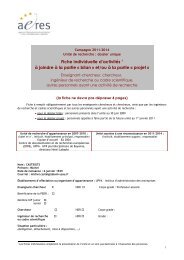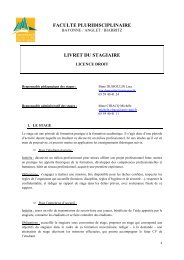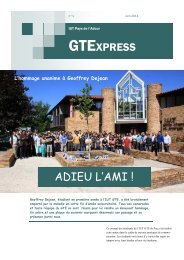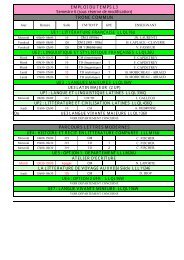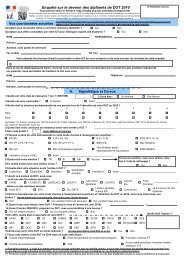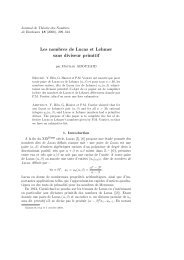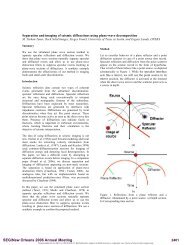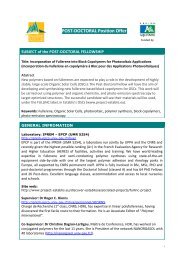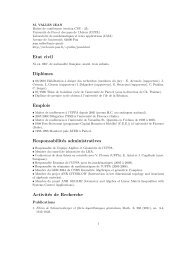Processus de Markov, de Levy, Files d'attente, Actuariat et Fiabilité ...
Processus de Markov, de Levy, Files d'attente, Actuariat et Fiabilité ...
Processus de Markov, de Levy, Files d'attente, Actuariat et Fiabilité ...
Create successful ePaper yourself
Turn your PDF publications into a flip-book with our unique Google optimized e-Paper software.
4.7 Rational symbols<br />
FILES D’ATTENTE, FIABILITÉ, ACTUARIAT<br />
The final result of the analytic approach is to yield Laplace transforms; for example, the<br />
Laplace transform of the perp<strong>et</strong>ual survival probability is given by the famous Pollaczek-<br />
Khinchin formula :<br />
ψ ∗ (s) =<br />
∫ ∞<br />
0<br />
e −su ψ(u)du =<br />
∫ ∞<br />
0<br />
e −su P[Ȳ ≤ u]du = κ′ (0)<br />
κ(s)<br />
(4.15) PK1<br />
where κ(s) is the ”symbol” of the process.<br />
From the Pollaczek-Khinchine formula(4.15), it may be seen that if the claims have a<br />
rational Laplace transform<br />
¯B ∗ (s) =<br />
∑ K−1<br />
k=0 a ks k<br />
s K + ∑ K−1<br />
k=0 b (4.16) Lappar<br />
ksk, then the same will be true of the Laplace transform of Ȳ and of the ultimate ruin probability.<br />
In this case, the Laplace transform may be inverted explicitly, either by a) the<br />
matrix-exponential formalism, or by b) splitting into partial fractions, yielding mixtures of<br />
exponentials involving the roots of the Cramer-Lundberg equation § .<br />
Exemple 4.7.1 The matrix exponential formalism. For light tailed claims with rational<br />
Laplace transform (4.16), the distribution may also be expressed in ”matrix exponential” form<br />
¯B(x) = βe Bx 1, ⇐⇒ ¯B ∗ (s) = β(sI − B) −1 1 (4.17) matexp<br />
with B a matrix of or<strong>de</strong>r K –see for example (?).<br />
AsmBla<br />
This representation ren<strong>de</strong>rs Laplace inversion unnecessary, and the ruin probability is<br />
”explicit” (see (?)) A00 :<br />
ψ(u) = ηe Qu 1, where Q = B + (−B)1η, η = β(−B) −1 . (4.18) phaseruin<br />
Note though that the matrix exponential representation is overparam<strong>et</strong>erized (K 2 param<strong>et</strong>ers<br />
instead of the 2K param<strong>et</strong>ers of the Laplace transform). Since the claims distribution is never<br />
certain, and the statistical estimation of matrix-exponential or phase-type representations is<br />
a notoriously difficult problem, the formula (4.18) is not necessarily the best way to approach<br />
the problem.<br />
Exemple 4.7.2 Suppose the claims are mixtures of distinct exponentials with positive or<br />
negative weights<br />
¯B(x) =<br />
I∑<br />
β i e −bix ,<br />
i=1<br />
∑<br />
β i = 1, b(x) ≥ 0, x ∈ R +<br />
i<br />
(with mean m 1 = ∑ I<br />
i=1 β ib −1<br />
i ).<br />
L<strong>et</strong> us apply the Pollaczek-Khinchin formula, exploiting the fact that for Cramér Lundberg<br />
processes, the symbol κ(s) = log ( E 0 e −sX(1)) may be written as κ(s) = s(c − λ ¯B ∗ (s)).<br />
§ For non-rational symbols, the task of Laplace inversion is more challenging; for example, the case of<br />
lognormal claims is not so straightforward.


